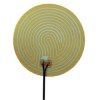Kavitha Seetharaman
New Member
We need a device to heat ferric chloride solution for etching process ...
How it could be heated ?
As it is highly corrosive , the solution should not come in contact with metals ..
the solution is to be heated up to 50 degree celsius....
How it could be heated ?
As it is highly corrosive , the solution should not come in contact with metals ..
the solution is to be heated up to 50 degree celsius....

